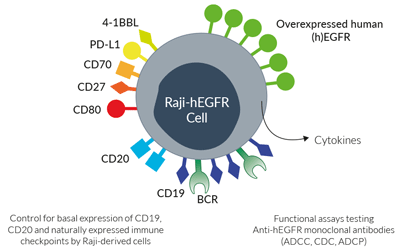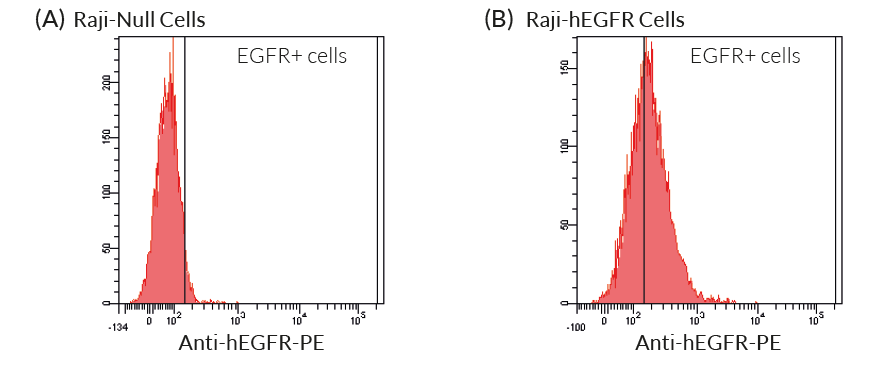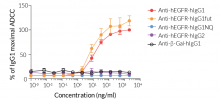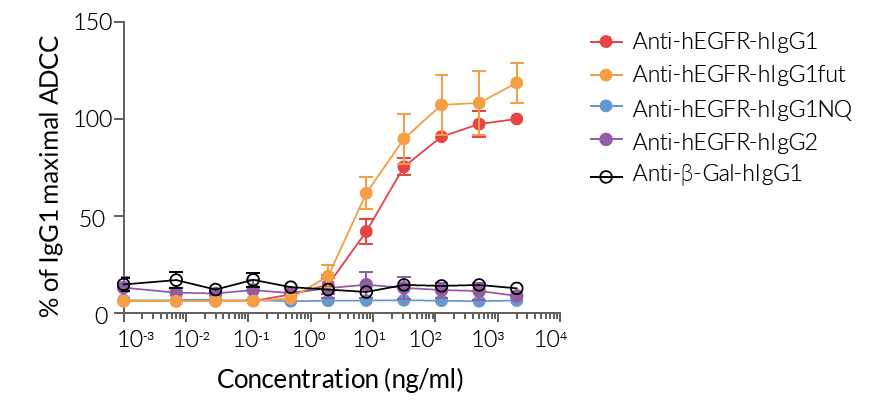Human EGFR-expressing Raji Cells
| Product | Unit size | Cat. code | Docs. | Qty. | Price | |
|---|---|---|---|---|---|---|
|
Raji-hEGFR Cells Human lymphoblast cells - ADCC EGFR Target Cells |
Show product |
3-7 x 10^6 cells |
raji-hegfr
|
|
Human EGFR-expressing B cells
Raji-hEGFR cells were developed from the human Raji cell line, a human B lymphocyte-derived cell line, and engineered to stably overexpress the human EGFR gene. Raji cells have been successfully used as target cells in human effector studies such as antibody-dependent cellular cytotoxicity (ADCC), either with peripheral blood mononuclear cells, natural killer (NK) cells, or T cell-derived Jurkat reporter cells.
Epidermal growth factor receptor (EGFR), also known as HER1 or ERBB1, is a member of the EGFR/ERBB family of receptor tyrosine kinases [1,2]. Under normal physiological conditions, activation of EGFR by various ligands, including epidermal growth factor (EGF) and transforming growth factor (TGF)–α, leads to the formation of an active EGFR-homodimer or heterodimer with another member of the ERBB family such as HER2. EGFR-dependent signaling is crucial in the regulation of tissue development and homeostasis [1]. However, uncontrolled surface overexpression and/or enhanced signaling activity of EGFR is a major driver of tumor progression (e.g. lung, breast, and glioblastoma) [1,2]. Thus, it is considered an important tumor-associated antigen and oncogene. EGFR-targeting monoclonal antibody (mAb) therapies (e.g. Cetuximab) have been approved for the treatment of a variety of cancers [1,2]. EGFR remains an important therapeutic target for the development of more potent mAbs (e.g. increased effector function).
Features of Raji-hEGFR cells:

Surface expressed markers in Raji-hEGFR cells
- Stable overexpression of the human EGFR gene
- Characterized by a number of cell-surface expressed markers including the B cell receptor (BCR), CD19, and CD20
- Constitutive expression of various immune checkpoints (ICs) such as CD27, CD70, CD80, PD-L1, and 4-1BBL
Applications for Raji-hEGFR cells:
- Target cell line for ADCC assays using InvivoGen's Jurkat-Lucia™ NFAT-CD16 cells
- Target cell line for cell toxicity assays using NK or CAR-T cells
- For use in the development of other functional assays
Validation of Raji-hEGFR cells:
- Overexpression of EGFR verified by flow cytometry
- Functionally tested as target cells in ADCC assays using anti-human EGFR mAbs and Jurkat-Lucia™ NFAT-CD16 cells
- Guaranteed mycoplasma-free
References:
1. Sigismund, S. et al. 2018. Emerging functions of the EGFR in cancer. Mol Oncol 12, 3-20.
2. Sabbah, D.A. et al. 2020. Epidermal Growth Factor Receptor (EGFR) Structure, Signaling Pathways, Interactions, and Recent Updates of EGFR Inhibitors. Curr Top Med Chem 20, 815-834.
Specifications
Antibiotic resistance: Blasticidin
Growth medium: IMDM, 2 mM L-glutamine, 25 mM HEPES, 10% heat-inactivated fetal bovine serum (FBS; 30 min at 56 °C), 10 μg/ml Blasticidin, Pen-Strep (100 U/ml-100 µg/ml), 100 µg/ml Normocin™
Test medium: IMDM, 2 mM L-glutamine, 25 mM HEPES, 10% heat-inactivated FBS, Pen-Strep (100 U/ml-100 µg/ml)
Quality control:
- Human EGFR expression has been verified by flow-cytometry.
- Induction of antibody-dependent cellular cytotoxicity (ADCC) has been validated using anti-hEGFR antibodies and InvivoGen's Jurkat-NFAT Lucia™ CD16 reporter cell line.
- The stability for 20 passages following thawing has been verified.
- Raji-hEGFR cells are guaranteed mycoplasma-free.
These products are covered by a Limited Use License (See Terms and Conditions).
Back to the topContents
- 3-7 x 106 Raji-hEGFR cells in a cryovial or shipping flask.
- 1 ml of Blasticidin (10 mg/ml). Store at 4 °C or at -20 °C.
- 1 ml of Normocin™ (50 mg/ml). Normocin™ is a formulation of three antibiotics active against mycoplasmas, bacteria, and fungi. Store at -20 °C.
IMPORTANT: If cells are shipped frozen (i.e. in a cryovial) and are not frozen upon arrival, contact InvivoGen immediately.
![]() Shipped on dry ice (Europe, USA & Canada)
Shipped on dry ice (Europe, USA & Canada)








